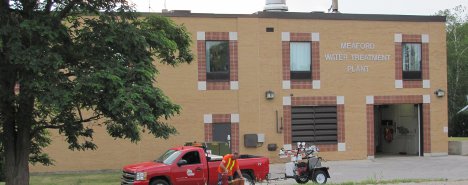By Stephen Vance, Staff
The future infrastructure bills keep adding up. In 2012 TMI reported that nearly $20 million would need to be spent on Meaford bridges and culverts over the next ten years. In September of 2013 it was reported that some $130 million would be required for municipal infrastructure asset replacement over the next 25 years in the Operations Department alone – that number included roads, bridges, and water facilities. This week council received a lengthy and exhaustive report on the state of the municipal water and waste-water systems, and council was told that $54 million will be required for those facilities in the coming years.
“The purpose of the study was to look at your existing system, and see what was required to upgrade it to support growth, and also to look at the existing problems that you have with your existing system,” Gary Scott, of consulting company Ainley Group, told council at their May 11 meeting.
In his report, which is the result of a year-long study, Scott identifies several deficiencies in the municipal water and waste-water systems including:
Water System
-
The Bighead River siphon was identified as a potential hydraulic bottleneck if no inflow/infiltration remediation is conducted.
-
It was determined that there are some areas in the system that did not meet minimum requirements for pressures and available fire flow, which is a result of old and small diameter watermain and the non-compliant water booster pump station (Nelson St. BPS).
-
The main pressure zone suffers from pressure fluctuations that affect the areas of higher elevation.
-
The Nelson Street Booster Pump Station does not comply with MOECC design guidelines and does not provide adequate pressures under all demand conditions.
-
The total storage within the system is 2,880 m 3 , and the required storage based on MOECC design guidelines is 2,166 m 3 . There is adequate storage for existing demands and fire flow requirements. Additional storage will be needed to service full build-out.
Waste-Water System
-
Previous studies at the plant have indicated that aspects of the plant design do not meet the current MOECC Guidelines and the plant will likely have issues with denitrification at flows in excess of 2,600 m 3 /d.
-
Average Biological Oxygen Demand (BOD) (120 mg/L) and Total Suspended Solids (TSS) (137 mg/L) influent concentrations represent a fairly weak sewage strength, likely due to high storm-water inflow and infiltration levels.
-
Components of the original plant constructed in 1969 require extensive upgrades including: Secondary clarifier mechanisms – RAS/WAS pumping station Main electrical panel – Stand-by power generation.
-
The plant has no separate grit removal process.
-
The plant has no automated control systems.
-
The UV disinfection system requires an additional module for standby capacity.
-
The plant will require an ongoing program of major maintenance due to the age of the equipment and systems.
-
Encrustation of sewer pipes is endemic throughout the collection system as identified by CCTV inspection.
-
Pipe defects such as circumferential and longitudinal cracking, joint displacements, and faulty connections are common and a result of an aging system.
-
Several locations have been identified with severe pipe defects including breaks and deformations.
-
Flow monitoring has identified a rapid response to rain events indicating that the system has an issue with inflow. This issue extends beyond the commercial area; it is expected that eavestrough, sump pump and tile drain connections are common.
The total estimated cost for the repairs and upgrades is $54 million over the next 25 years according to Scott’s report. Funding would come from a combination of development charges and system user fees.
The full report can be found on the municipal website.












